Manchester United welcomed what was an out of form Arsenal to Old Trafford for Ole Gunnar Solskjær‘s 100th game as Manchester United boss. The visitors came away as worthy ‘0-1’ winners, Pierre Emerick Aubameyang converted from the spot on ’69 minutes, the hosts unable to find a reply.
Arsenal boss Mikel Arteta will be particularly pleased as his side had not won a Premier League game at Old Trafford since 2006. Arsenal seemed to have the edge technically, tactically and physically across the 90 minutes, reducing their bitter rivals to an unfamiliar xG of 0.23
Perhaps the UEFA Champions League demands this past week was too much on Solskjær’s men going into this game. However, besting Arsenal in possession for extended periods of the game chances came few and far between.
The tactical analysis below looks at the key aspects of both sides performance, here we analyse the tactics that ultimately decided both teams fate as well as all the major talking points that took centre-stage.
Lineups
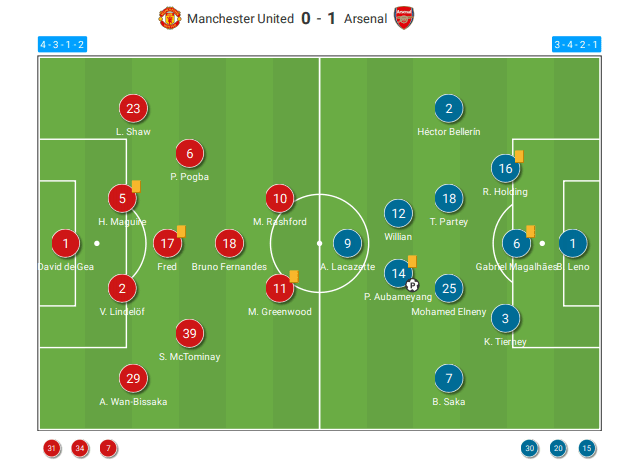
Manchester United: 4-3-1-2
Solskjær makes two changes to the side that triumphed 5-0 over RB Leipzig midweek. Suspended Anthony Martial exits the squad this week, while Nemanja Matić starts on the bench making way for Marcus Rashford and Bruno Fernandes. In the second half Fred, Fernandes and Mason Greenwood return to the bench to facilitate the fresh legs of Matić, Donny Van De Beek and Edison Cavani.
Arsenal: 3-4-2-1
Mohammad Elneny is the only player that kept his spot in the team that won 3-0 victory against Dundalk in the Europa League this past week. Bernd Leno started in goal while Keiran Tierney, Gabriel and Rob Holding make up the back three. Operating on the flanks was Bukayo Saka and Héctor Bellerín while inside was Elneny and new midfield powerhouse Thomas Partey. While Aubameyang, Alexandre Lacazette and Willian made up the front three from left to right respectively.
A brief overview
Arsenal dominated the first and most of the second half, controlling the game well both in and out of possession. Few chances were created by either side, Manchester United with 2 shots on target from 8 attempts while Arsenal managed 2 shots on target from 7.
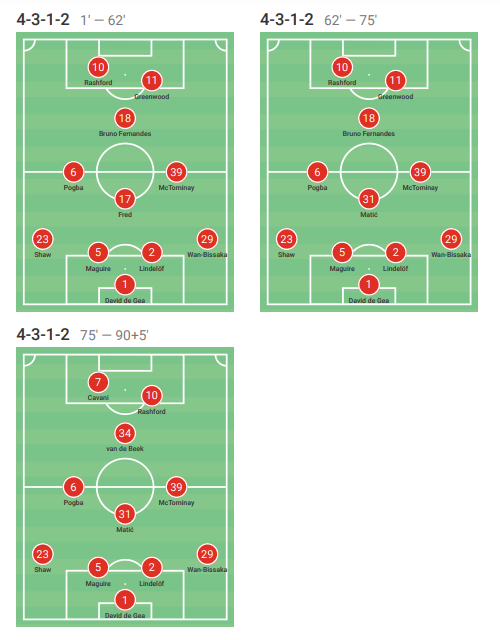
Manchester United formations across 90+ minutes. Solskjær withdrew Fred on ’62 minutes having picked up a yellow card in the first half he was replaced by Matić in a like for like substitution. By 72′ minutes, Fernandes and Greenwood were withdrawn and replaced by Van De Beek and Cavani. Fernandes perhaps lacked intensity out of possession in his manager’s eyes, while Greenwood who had already picked up a yellow was always the likely candidate to make room for the introduction of Cavani.
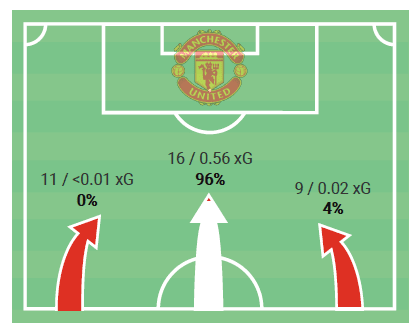
Manchester United’s attack by flanks data. Observe the volume of attacks and accumulative xG rating per each flank. United’s highest probability of scoring came from the central channel. This was Maguire’s headed attempt on goal in the second half from a set-piece.
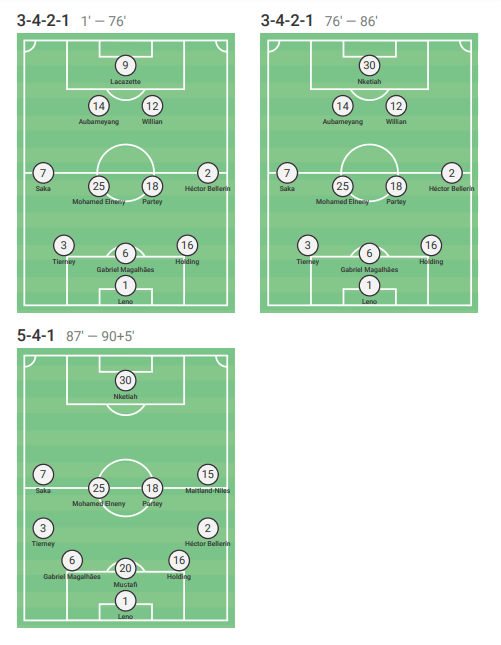
Some variability and lopsidedness going forward in this game, the back-three became a back-two in the attacking phase as Tierney would depart from the backline to add value from crossing positions on the left. Arteta’s Arsenal was in control for the first 75 minutes, and it seemed when the Gunner’s had a lead to defend and only youth to call on from the bench, their character was really tested as the North Londoners morphed into a 5-4-1.
A concern for the young Spanish manager early in the game, two of his three centre-backs picked up a yellow before half-time. Perhaps forcing his hand when considering substitutions; however, they seemed to evade further trouble with referee Mike Dean. Which subsequently allowed Arteta to replace Lacazette with Nketiah on 76 minutes and Aubameyang with Maitland-Niles and Willian with Shkodran Mustafi on 86 minutes. This offered Arsenal fresh legs upfront to sustain the pressing intensity coupled with Mustafi’s leadership at the back.
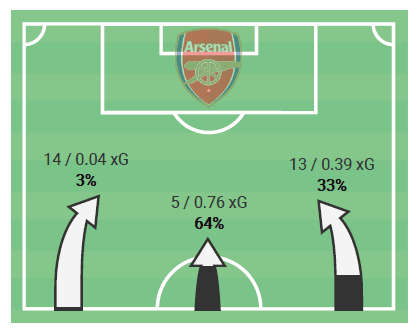
Arsenal’s attacks by flanks data. Observe the volume and corresponding xG per each flank. The higher volume of attacks come by way of attacks in the wide channels; however, the superior xG in the middle is due to Aubameyang’s converted penalty.

Possession data across 90+ minutes. No team was dominating for more than 10—15 minutes at a time, a slightly unusual trend for possession data.
Arsenal play through United’s high press
Similar to Arsenal, United occupied a high-block when Arsenal played out from the back, waiting for the ball to be one side of the pitch before engaging the press. United’s front three moved in unison to engage the press and mark up Arsenal’s passing options in midfield. Arsenal did superbly well to pass and receive under pressure on the edge of their box while making lateral passes to find an outlet into midfield.
At times Arsenal was forced to play long passes from deep when passing options were nullified. It was here Arsenal were prepared and done well, with 70% long pass completion to one of the front three (23) in contrast to United’s long pass success rate of just 40% (14). Once play had progressed beyond United’s midfield Arsenal were quick to create overloads in wide areas when entering the final third. Often Tierney would step up and support his teams in the final third.
Below, we will look at one moment that captures Arsenal’s attacking principles from back to front in this game. A ten pass move that starts with the goalkeeper playing combinations with Gabriel and Tierney who ultimately delivers a dangerous cross into the 6-yard box.
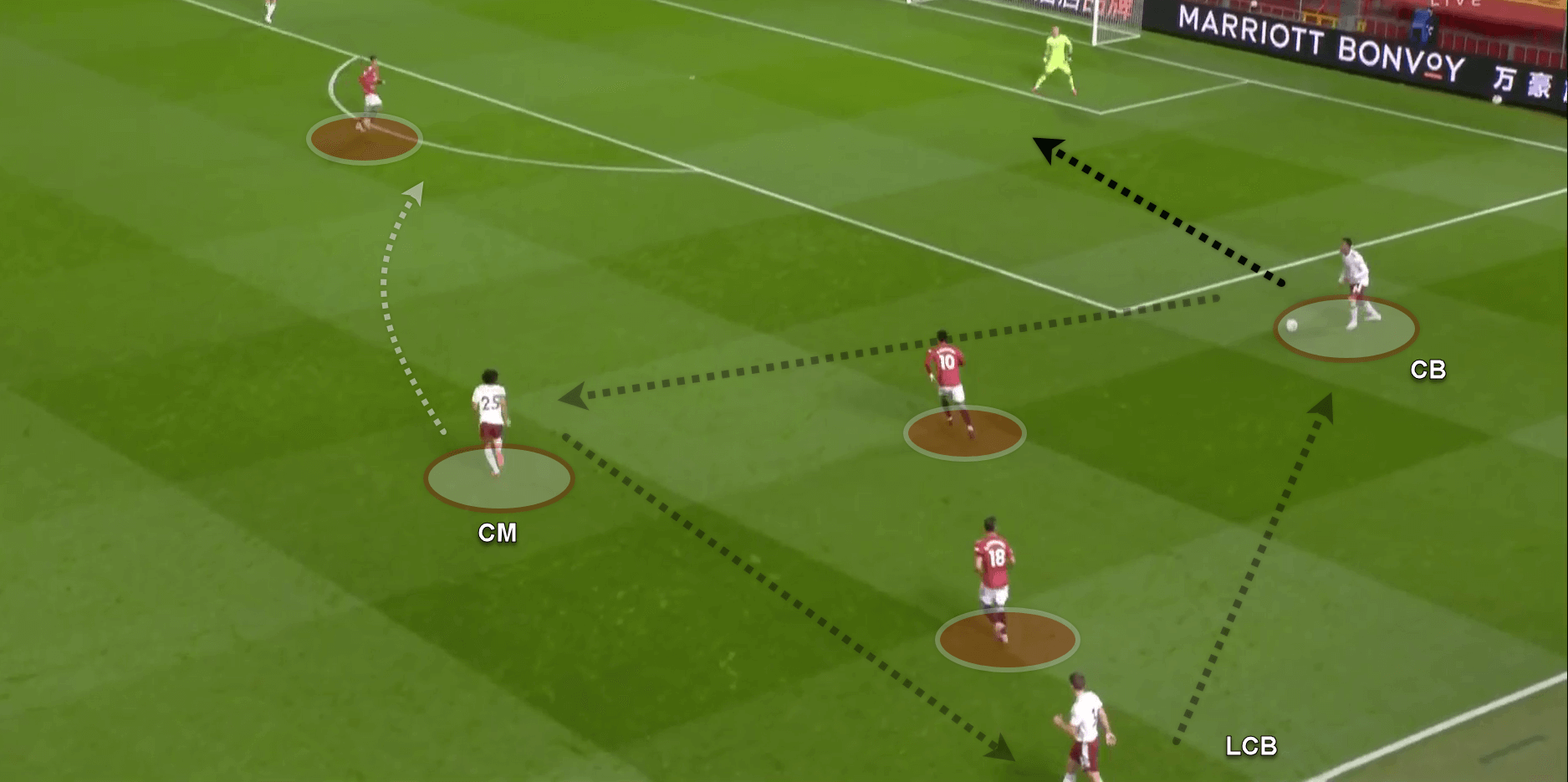
In the image above, play starts with Leno playing a short pass to ‘CB’ Gabriel. Elneny does well to lose Fernandes as he receives a pass, which then subsequently plays to ‘LCB’ Tierney, play returns back to ‘CB’ Gabriel, and Manchester United are now unbalanced centrally.
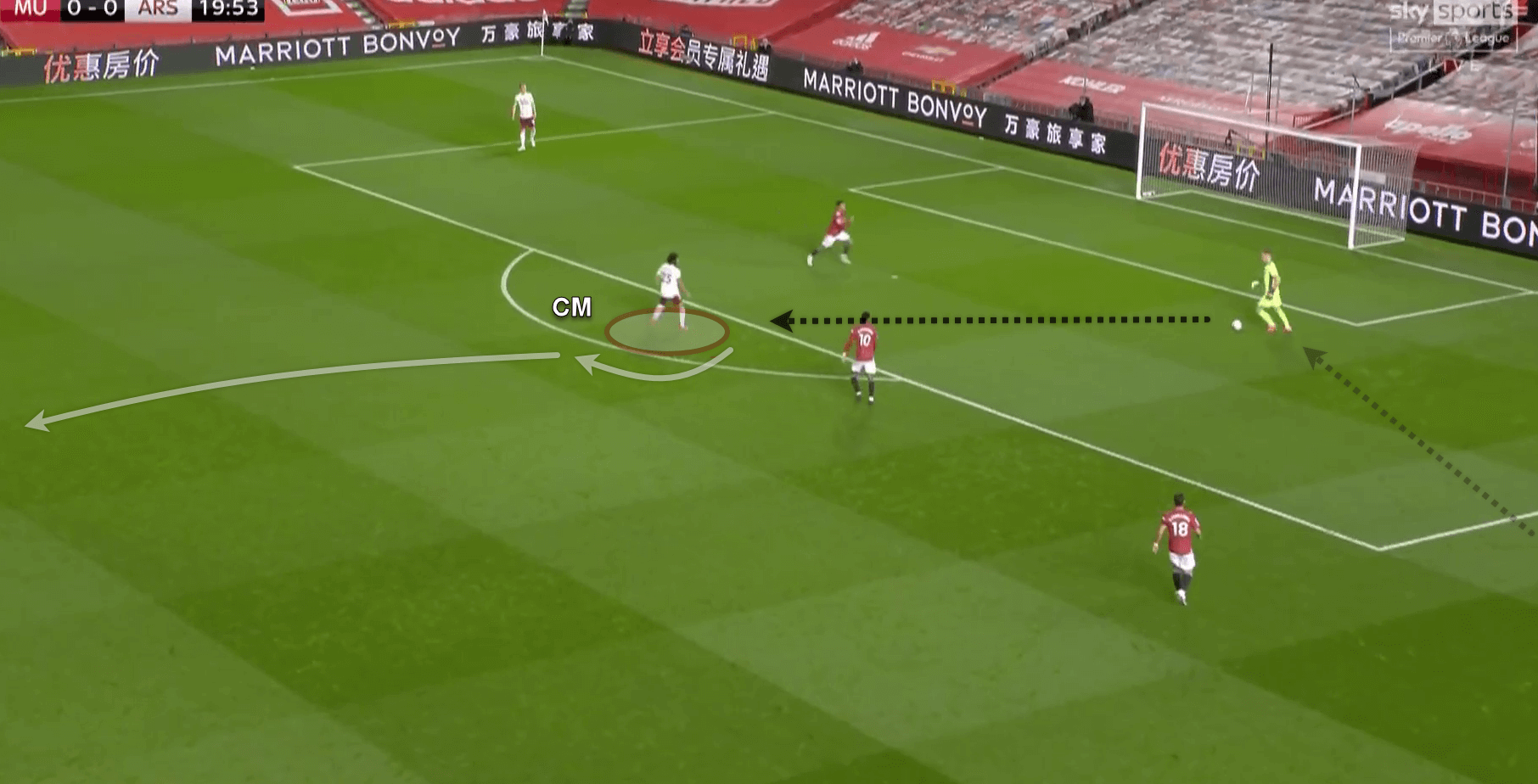
‘CM’ Elneny moves across and receives a pass from the goalkeeper Leno as he being closed down by the United forward. Elneny receives just inside the ‘D’ of the box, turns and dribbles at pace into midfield.
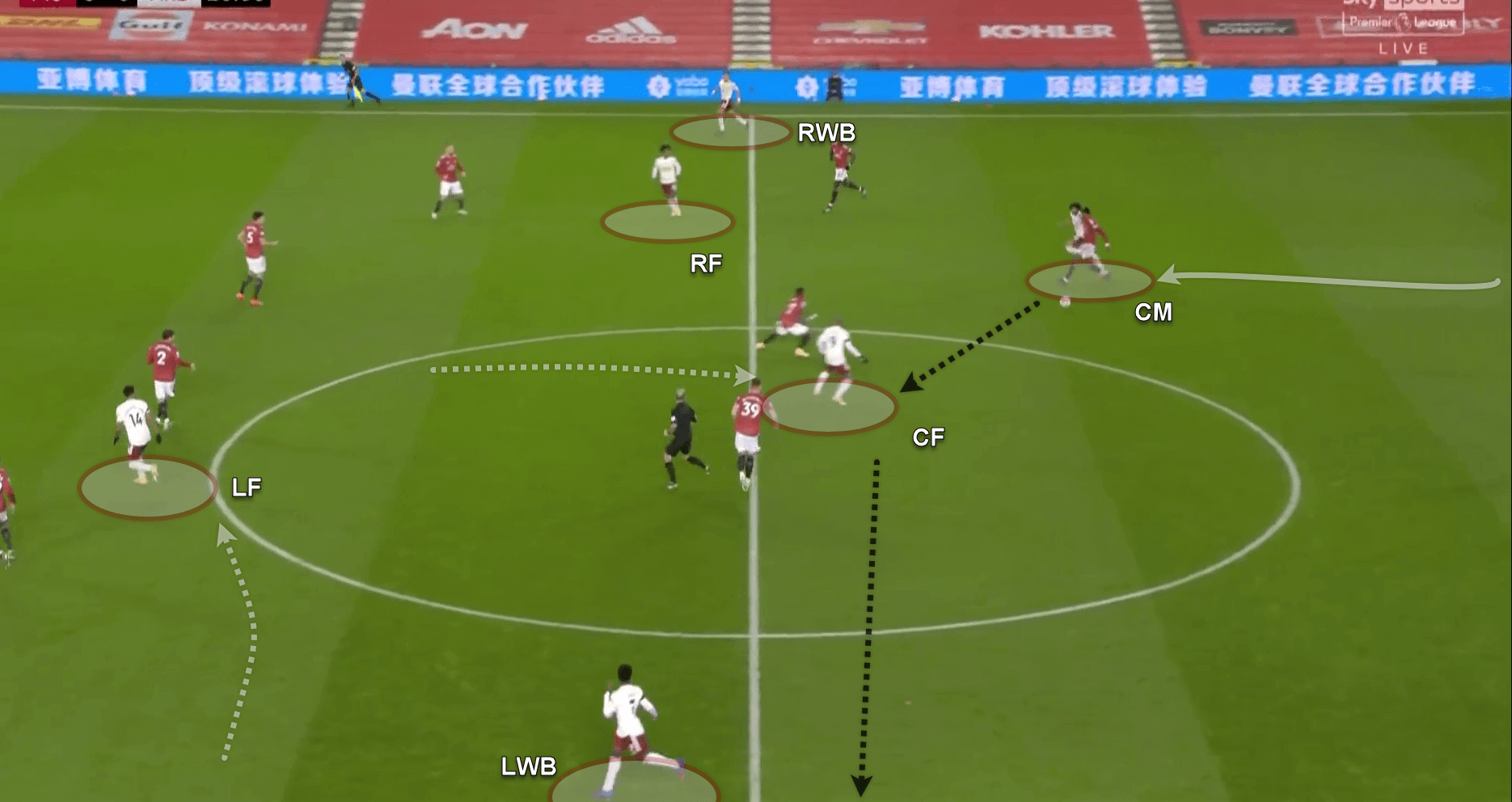
Elneny releases a firm ground pass to the ‘CF’ Lacazette. Lacazette makes a short move deep to receive the pass, which he then turns and plays out wide to the advancing ‘LCB’ Tierney.
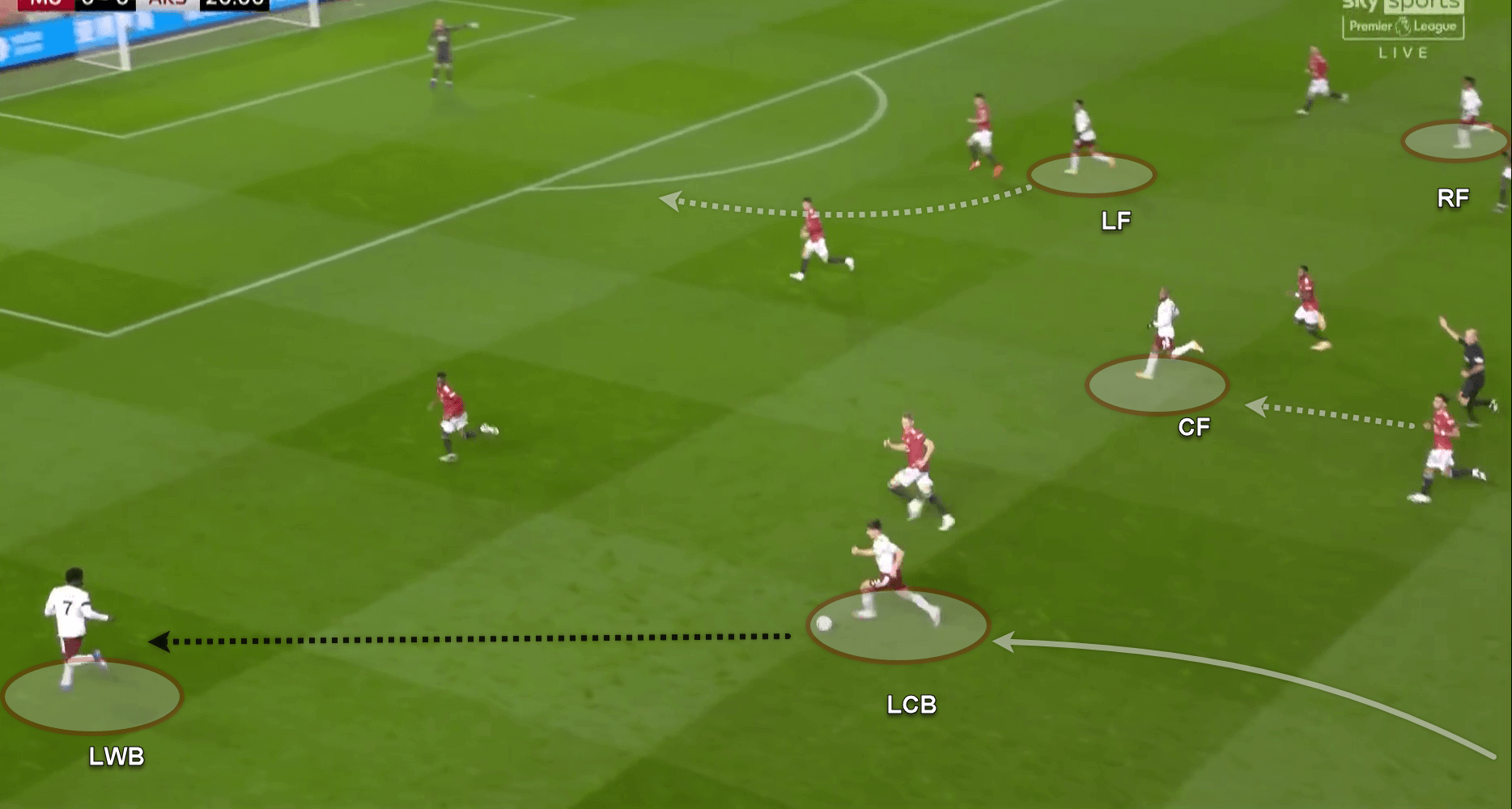
Tierney drives forward and releases a pass to the wing-back Saka outside on his left. At this stage, the Arsenal forwards adjust and prepare to be in the best position to attack a cross.
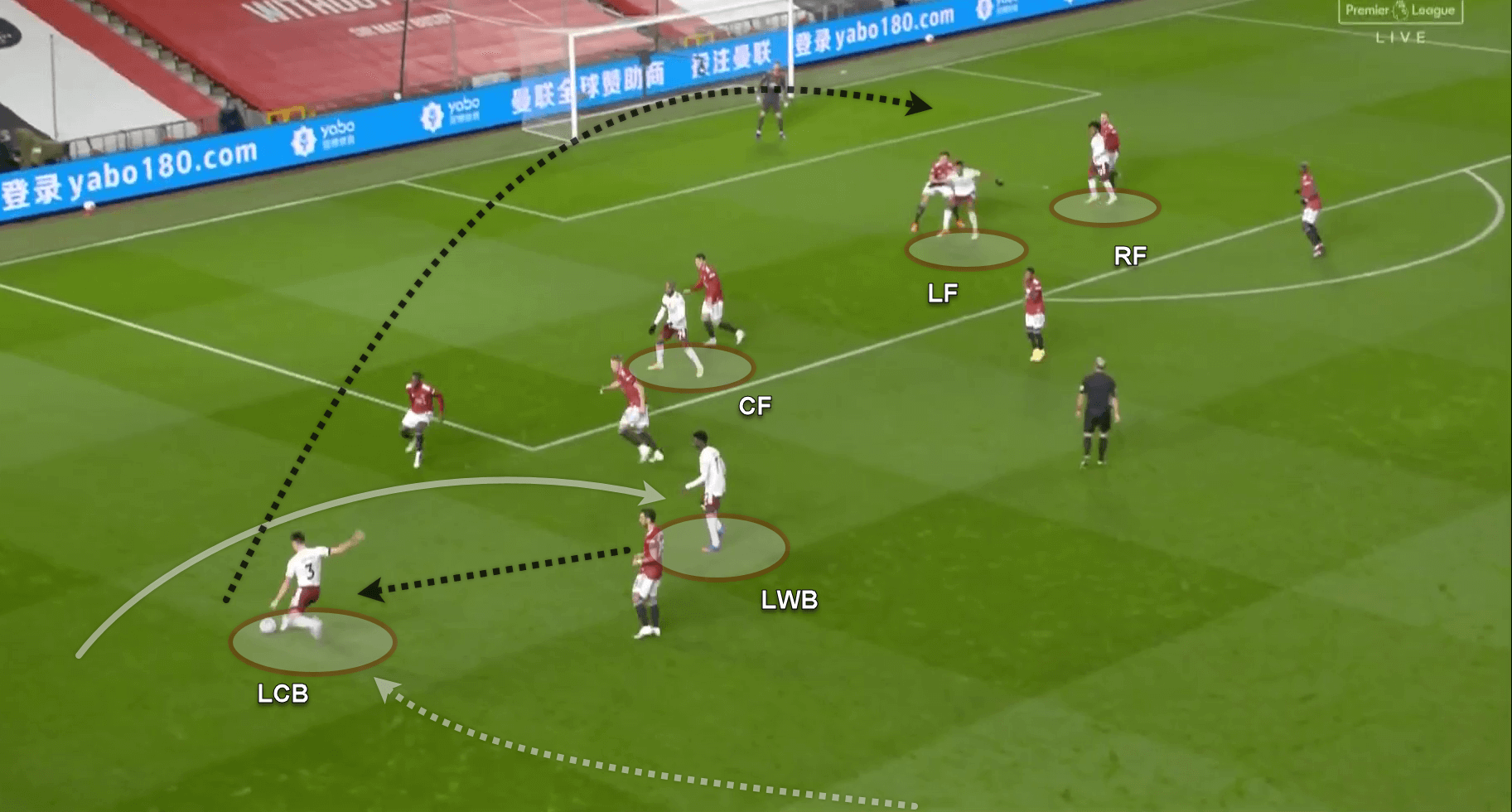
Saka turns, dribbles inside, then release a short pass outside to the ‘LCB’ Tierney. The young Scottish defender takes a touch before delivering a great cross to the back post to meet the ‘RF’ Willian. Willian’s headed effort calls the United goalkeeper into a simple catch on this occasion.
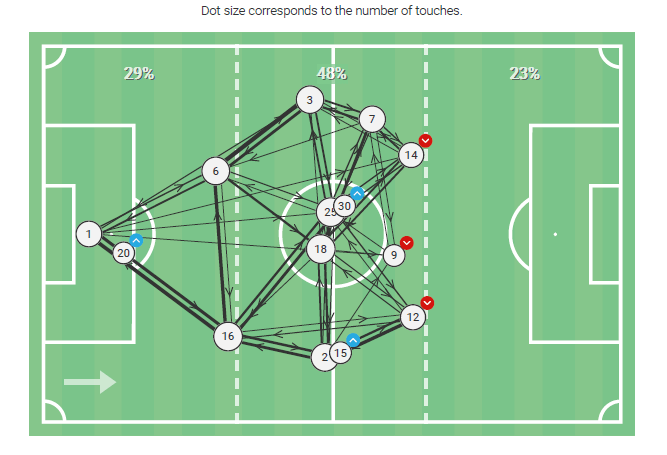
Above, Arsenal’s passing network, accounting for combinations of three or more passes in the final 60% of the field. Observe the equal distribution and balance between the left and right side of the field as well as between all the units. Arsenal players here showing a positional discipline in possession. By my experience, such balanced passing networks often reflect a team that made good decisions going forward. Perhaps, symbiotic with clarity in ones own attacking principles.
Arsenal was tactically astute and efficient in the build-up, although it’s hard to give evidence in writing, the Arsenal midfield and forwards done superbly in winning the very physical battles against a tough united midfield and defence.
As a lot of Arsenal’s play graduated into the wide areas, by creating overloads on the flanks and half-space channels the Gunner’s targeted back-post crosses against an unbalanced United defence.
United rely on quick transitions to get success
Although the heading does not offer much by way of a compliment to United’s attacking style of play, the Red’s done well on a few occasions against a well-disciplined and intense Arsenal high press. In the build-up, United would create a back five, by having Fred drop level between the two centre-backs Harry Maguire and Victor Lindelöf.
Looking to create overloads from deep, United done so successfully at times with Scott McTominay moving from right-midfield to centre-midfield and Bruno Fernandes moving across to the right, United would have one of these two players free to receive a pass unmarked.
If Arsenal were unsuccessful in the initial press from the front, efforts would be doubled to win the ball back in the middle third. Making it very difficult for United to progress and develop an attacking shape in the final third, United were forced to play long passes to either Greenwood or Rashford as they looked to exploit a disjointed Arsenal backline.
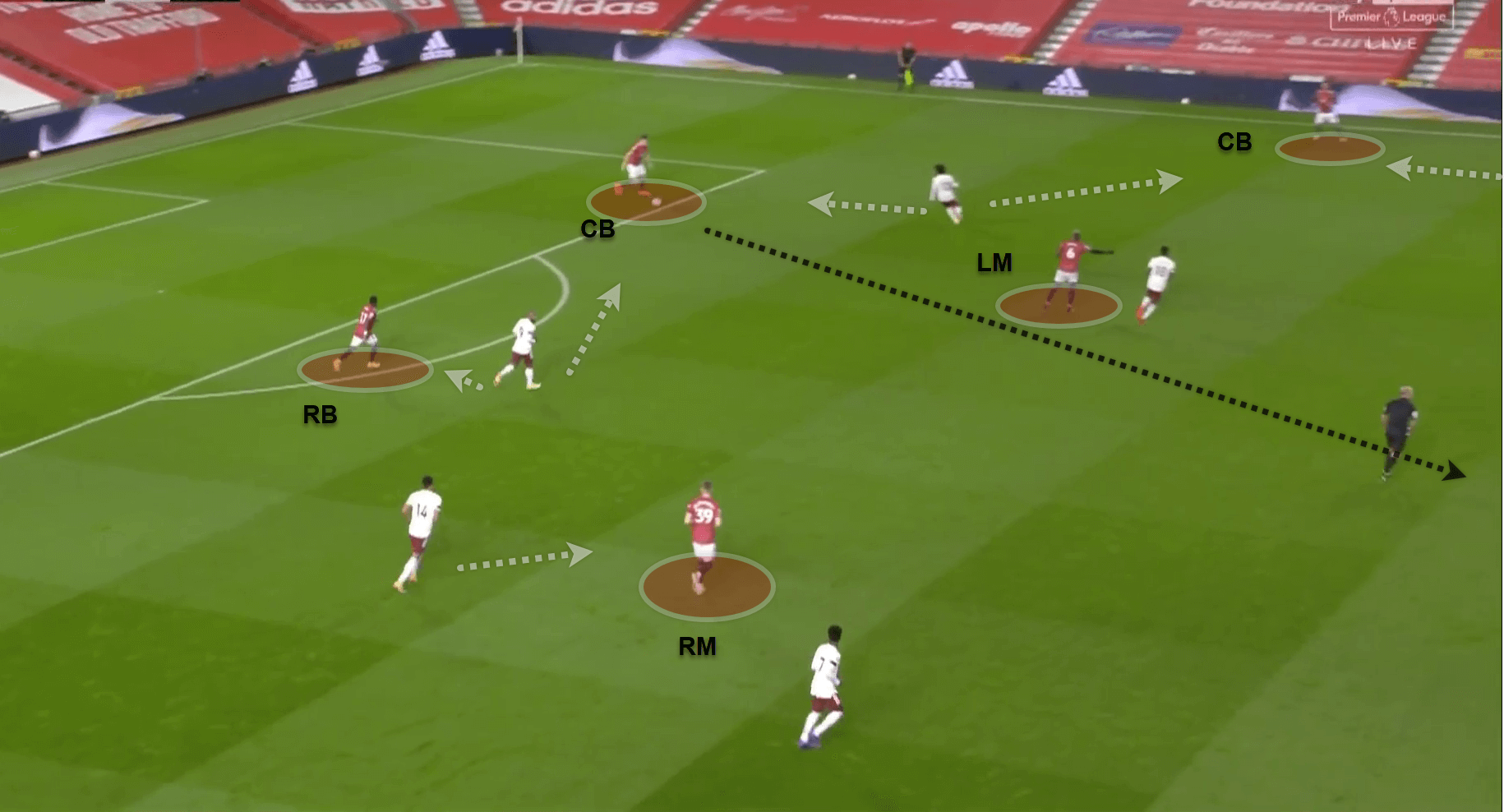
Above, we see a moment United are forced to go long as Arsenal move to engage the press from the high block. ‘CB’ Lindelöf plays a long pass to meet the feet of Rashford.
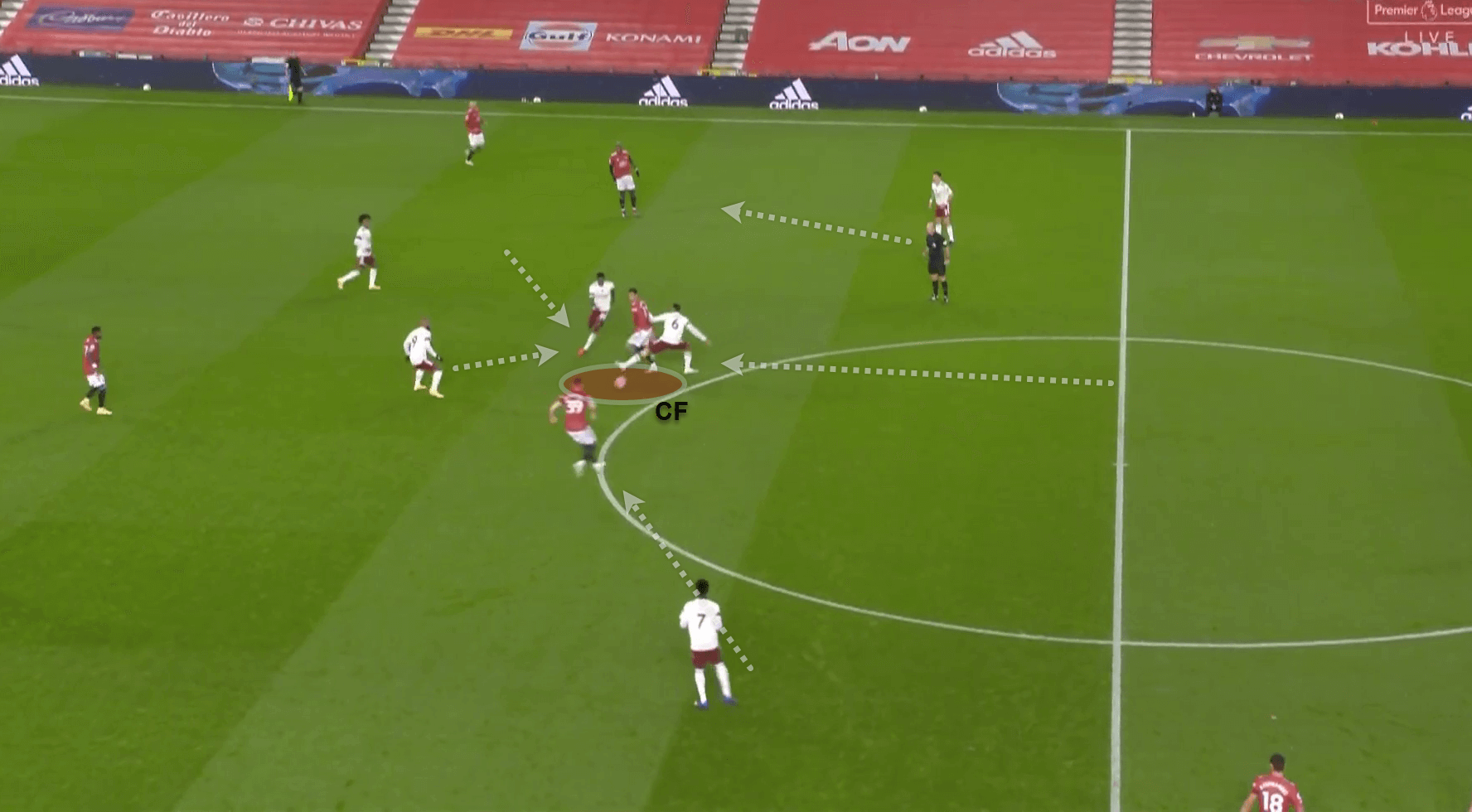
Before Rashford has a moment to look and take a second touch three Arsenal players move aggressively to engage the press, forcing the United frontman into making an error. Arsenal’s centre-back, centre-forward and central-midfielder pounce on the young English target man. Arsenal’s organisation and intensity forced United into other options.
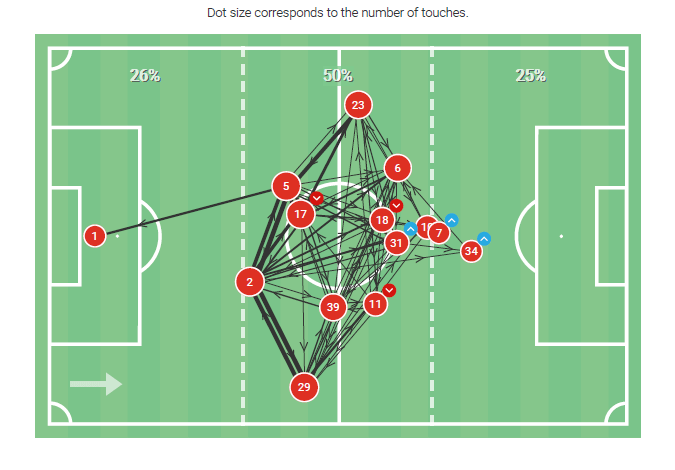
Above, United’s passing network, accounting for combinations of three or more passes in the final 60% of the field. The denser lines reflect the players and units linking more frequently in possession as well each player’s average position in possession. United’s midfield and forwards attacking very narrow as evidenced by the data. By my experience, the lack of balance, as well as the short vertical distances between the units, often reflects a side that might not have had clarity in their attacking principles.
Below, we will see three images that capture somewhat Man United’s attacking ideas in principle, for most of the game. Short passes between two or three fast ball-carriers, Fernandes, Greenwood and Rashford in the hunt to score against a stretched Arsenal defence.
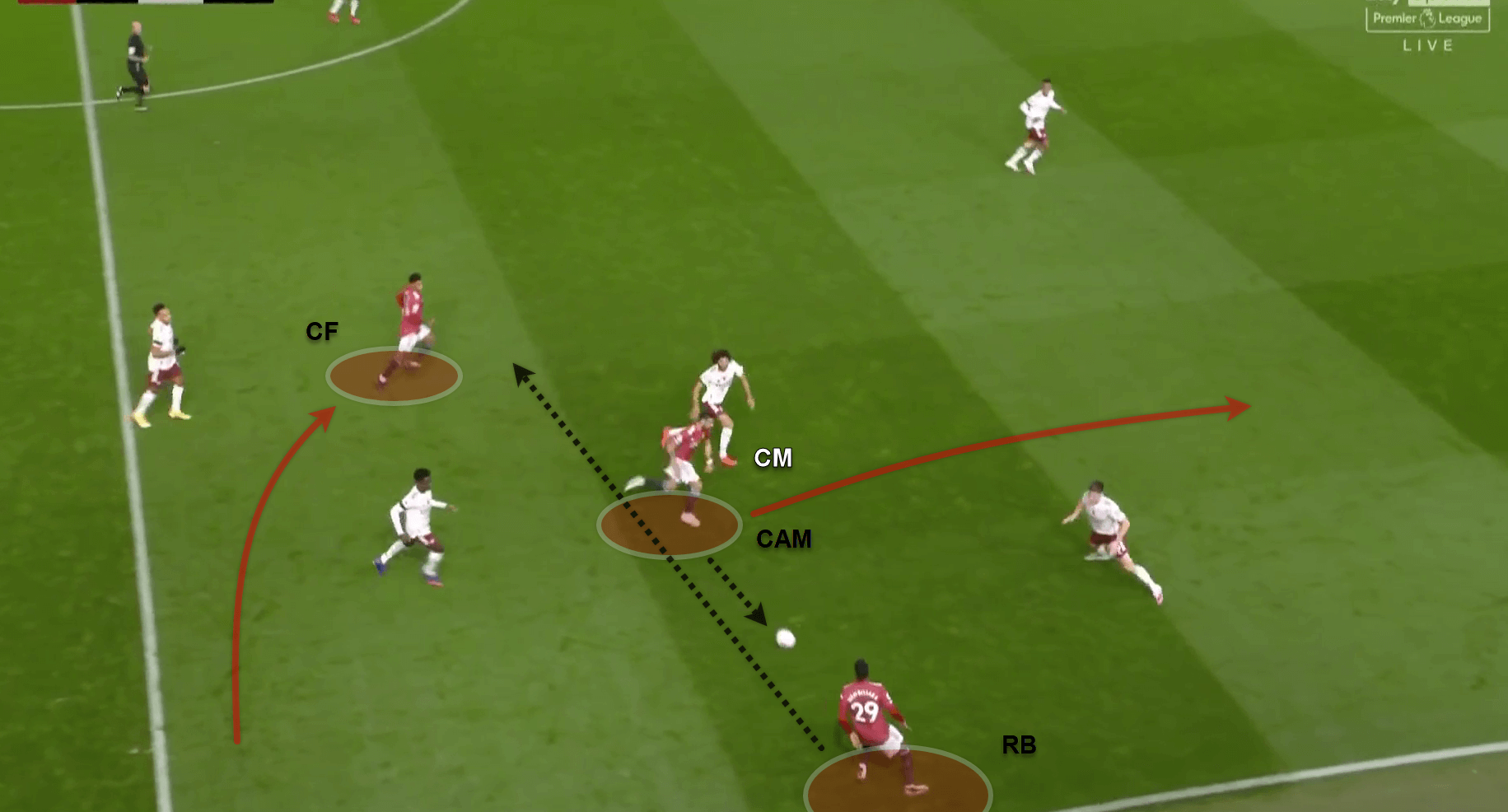
United win possession back in midfield, immediately they move forward in the transition to attack. Fernandes plays a pass to the right-back Aaron Wan-Bissaka who plays a quick pass back inside to the unmarked Rashford. Fernandes continues his run forward, creating the space for Rashford to receive by pulling the Arsenal ‘CM’ into the channel.
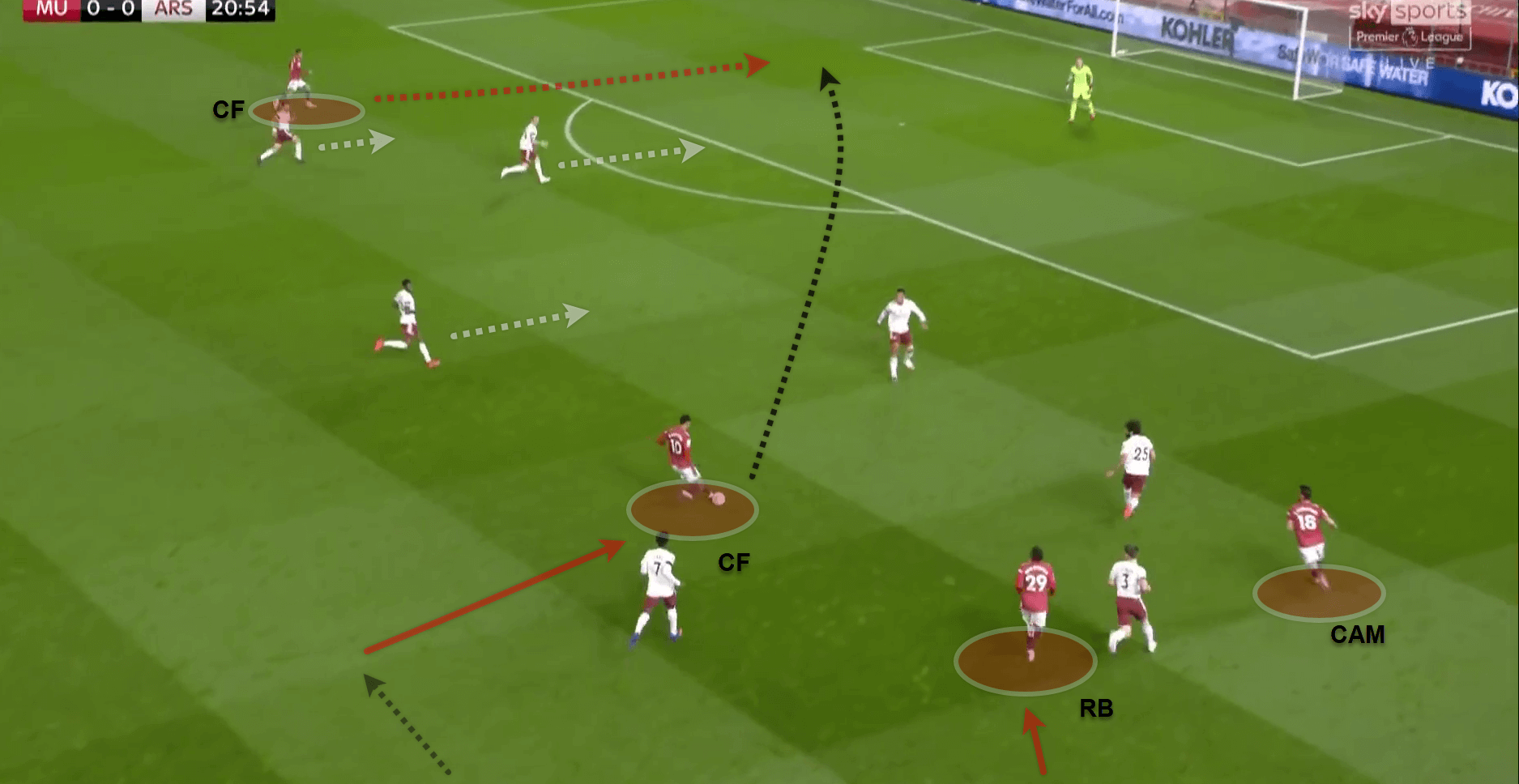
Rashford drives forward and releases a long ground pass forward and across the field to meet the run of Greenwood coming from the opposite flank. A super bit of skill from Rashford as both the pass and the timing was perfect as he fed a firm ground pass worthy of a goal.
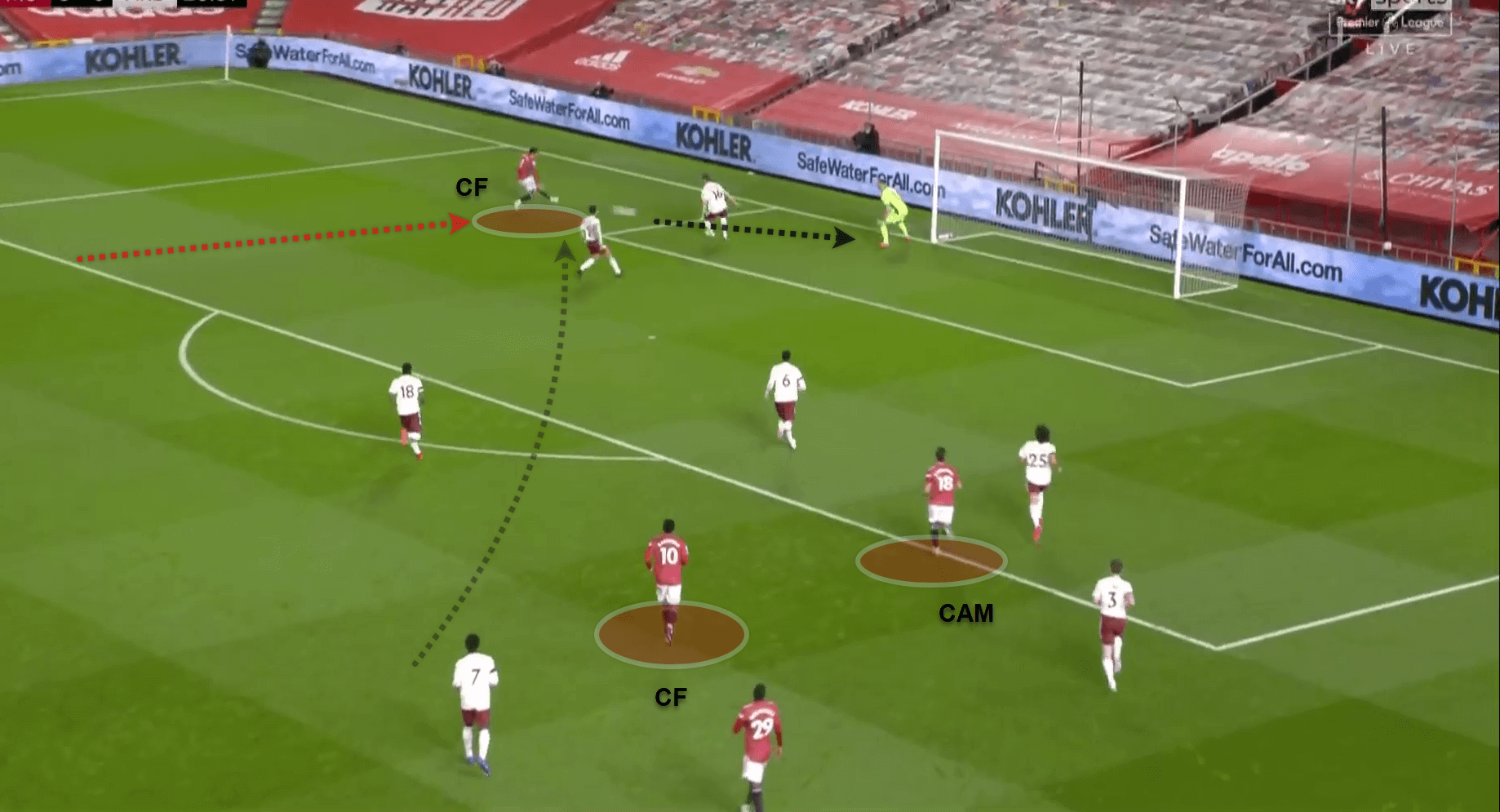
Greenwood latches onto the forward pass, adjusting his body and hitting hard and low to the near-post on his first touch. Leno does his best to stop the hard shot from hitting the target; United win a corner.
For most of the game, in fact, until they went a goal behind on ’69 minutes when the Red’s found a resurgence in their game, United struggled to show much promise going forward, with only 2 on target from 8 attempts.
Resorting to this style of play forced the hosts into many errors. Arsenal made a staggering 53 interceptions and had a PPDA of 6.3 at the peak of their defensive intensity. Although that average levelled out later in the game as United became more dominant with an average of 10.8 (allowed passes per defensive action).
United bombard the box, but Gunner’s prevail
Late in the game, United was dominant, with 75% possession in the last 15 minutes, a few factors for this change should be considered. Arsenal had a lead to defend, in a game that presented few chances for both sides. Arsenal recalled what would be their elder-statesmen to the bench, Aubameyang and Lacazette.
The nerves of youth defending a lead at Old Trafford perhaps, and United’s aggressive ‘nothing to lose’ attitude going forward, the Gunner’s withdrew their attacking potential to keep it watertight at the back. Yet they still had a threat in the pacey Ainsley Maitland-Niles and Eddie Nketiah to play on the break as United committed all ten outfielders to final third in the dying embers of the match.
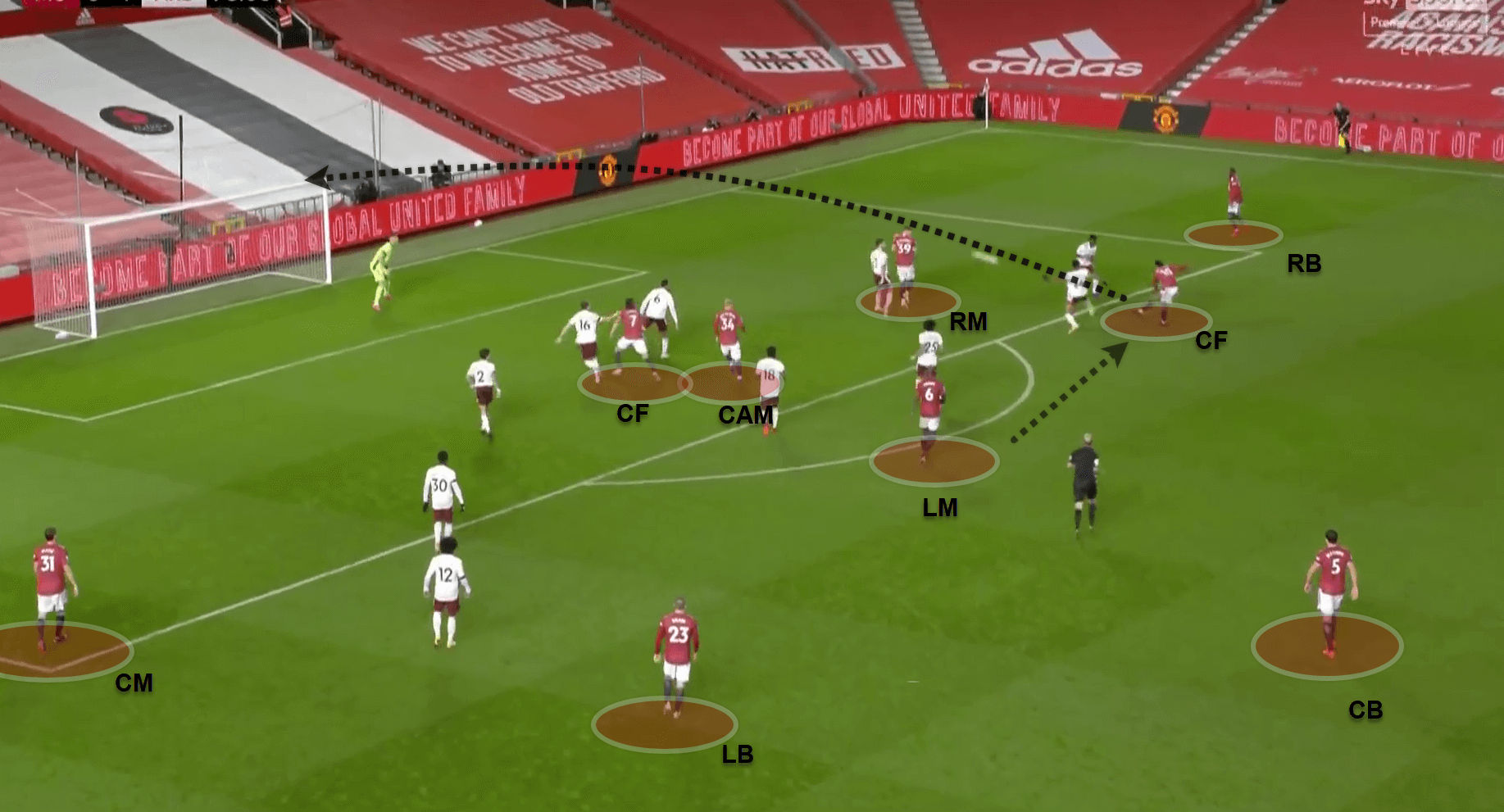
Above, Rashford hurries a shot from an acute angle as he is closed down on the edge of the box. Observe the numbers United have pushed forward, with only centre-back Lindelöf out of frame on the right. Arsenal have almost nine of their ten outfielders inside the box desperately defending their goal in the final minutes.
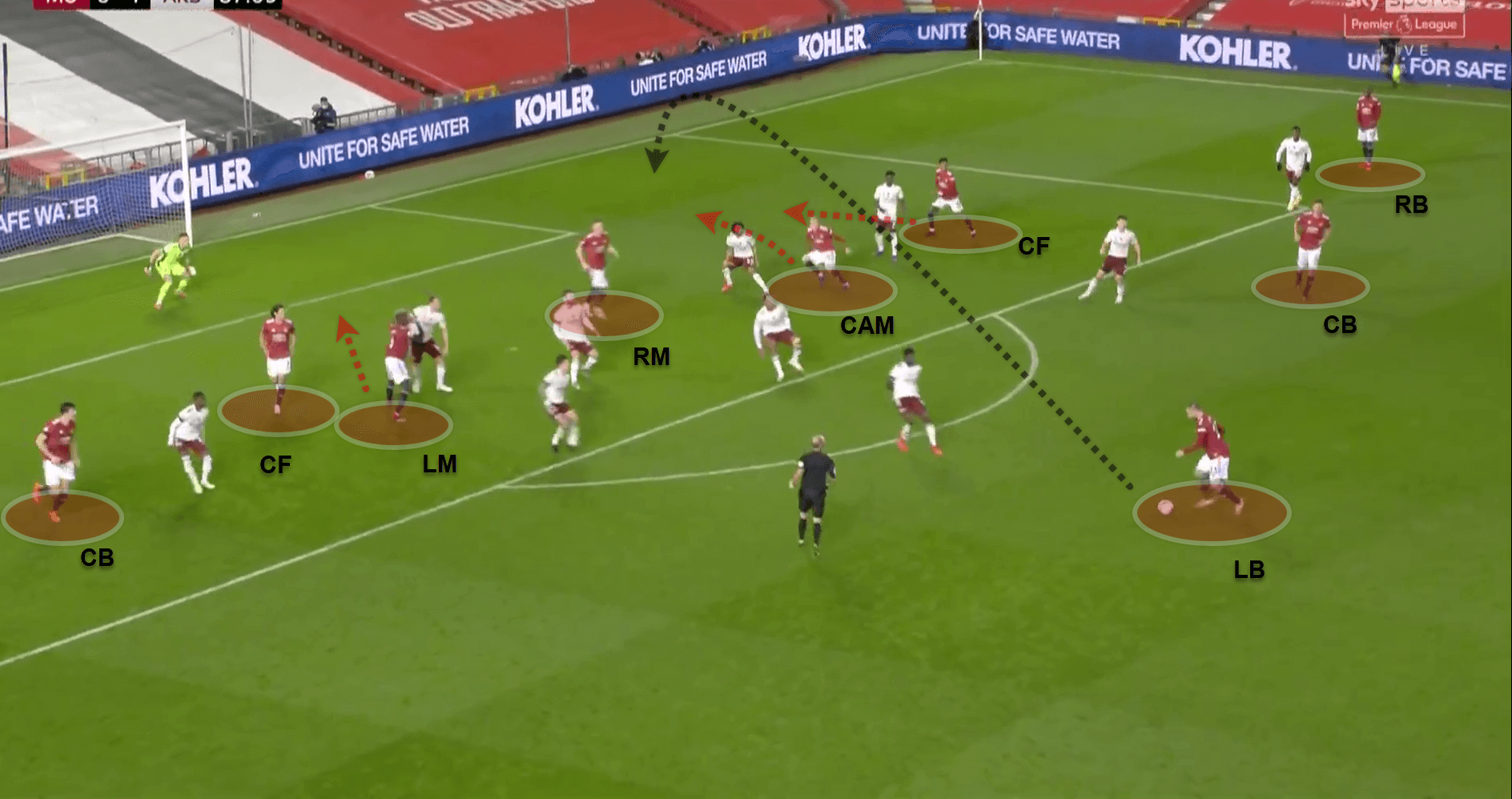
Man United left-back picks up a defensive clearance, adjusts his body and delivers another dipped cross to the corner of the 6-yard box for Rashford to playa knock-down header across the face of goal.
Arsenal did well not to break under unrelenting pressure, making 26 clearances across the 90+ minutes, the bulk of them tallied up in the final ten minutes, in contrast to United’s 7. There was no let-up as Arsenal had no forwards out to press the clearances, This allowed united to move the ball quickly, stretch the defence, making Arsenal run and press intensely for 15 + minutes.
Conclusion
Perhaps a good opportunity to change his fortunes was missed by the United boss. As two of Arsenal’s centre-backs were already booked at half-time, it’s likey a footrace against Rashford or Greenwood would give high probability to a second booking and a dismissal if provoked to foul by either centre-back. We will never know if it was considered; however, one has to think of the value in a game where winning and losing is separated by fine lines.
Overall, Arsenal had the edge technically, tactically and physically for 90+ minutes, combined with the mentally tough youth who dug deep in the final 15 minutes, Arsenal earned the three points at Old Trafford.
It seems just as Solskjær is making a charge up the table and picking up big wins in Europe, he’s back in the hot seat with the media after one defeat. Accounting for the fact that United are playing twice, if not more on average, per week, it gives the manager little to no time at all to work on the training ground which will be reflected in the points over time.
Regards to fixture pileup, many teams with less quality and depth in their squad compared to United’s can make the same argument. Nonetheless, this day belongs to the Gunner’s, waiting 14 years to pick up three points at Old Trafford, Arteta seems to be doing the right things to win the hearts of the Arsenal faithful. Final score at Old Trafford, Manchester United 0 – 1 Arsenal.





Comments